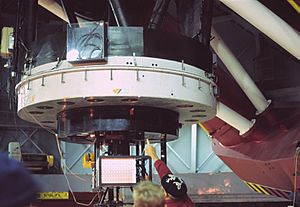Bernard Lyot facts for kids
Quick facts for kids
Bernard Lyot
|
|
|---|---|
| Born | 27 February 1897 Paris, France
|
| Died | 2 April 1952 (aged 55) Cairo, Egypt
|
| Nationality | French |
| Citizenship | France |
| Alma mater | University of Paris |
| Known for | Solar astronomy Coronagraph Lyot depolarizer Lyot filter Lyot stop |
| Awards | Lalande Prize (1928) Prix Jules Janssen (1932) Howard N. Potts Medal (1942) Gold Medal of the Royal Astronomical Society (1939) Henry Draper Medal (1951) |
| Scientific career | |
| Fields | Astronomy |
Bernard Ferdinand Lyot (born February 27, 1897, in Paris, France – died April 2, 1952, in Cairo, Egypt) was a brilliant French astronomer. He is famous for inventing the coronagraph, a special telescope that allowed scientists to study the Sun's outer atmosphere, called the corona, without waiting for a solar eclipse. His work greatly helped us understand the Sun.
Contents
About Bernard Lyot
Bernard Lyot loved reading about space from a young age. In 1915, when he was 18, he joined the French astronomical society. He started observing the stars using the society's telescope in Paris. Soon, he got his own telescopes, first a 4-inch (100 mm) one, then a bigger 6-inch (150 mm) one.
After finishing school in 1918, he worked at a famous school called the École Polytechnique. He also studied engineering, physics, and chemistry at the University of Paris.
Working at Meudon Observatory
In 1920, Bernard Lyot started working at the Meudon Observatory. He stayed there until he passed away. By 1930, he became an important astronomer at the observatory. He was known for being an expert in how light behaves, especially polarized light and monochromatic light (light of a single color).
Throughout the 1930s, he worked very hard to make his coronagraph even better. He invented this special telescope to observe the Sun's corona at any time, not just during an eclipse.
Challenges at Pic du Midi
Much of Lyot's important work was done at the Pic du Midi Observatory. This place was perfect for observing the sky because it had very clear air and no light pollution. However, getting there was a big challenge back then.
Before the 1950s, reaching the peak meant you needed good mountaineering skills. In winter, Lyot, who was a keen sportsman, would have to ski up using special skis with sealskins. The living conditions at the observatory were very basic. Later, a power line, a bigger building, and a cable car were built, making it much easier to access.
In 1938, Lyot showed a movie of the Sun's corona in action to a group of international astronomers. In 1939, he was chosen to be a member of the French Academy of Sciences. He became the Chief Astronomer at the Meudon Observatory in 1943.
From 1945 to 1947, Lyot was the President of the French astronomical society. Sadly, he had a heart attack while returning from a trip to observe an eclipse in Sudan. He passed away on April 2, 1952, at the age of 55.
Key Discoveries and Achievements
Bernard Lyot made several important discoveries and improvements during his time at the Pic du Midi Observatory:
- He found that the soil on the Moon acts like volcanic dust.
- He observed that Mars has large sandstorms.
- He greatly improved his coronagraph, making it more effective.
- He created motion pictures (movies) of solar prominences and the Sun's corona.
- He identified new spectral lines in the corona, which helped scientists understand its composition.
Amazing Inventions
Bernard Lyot invented several important tools for astronomy:
- Coronagraph: This is his most famous invention. It's a telescope that blocks out the bright light from the Sun's main disk. This allows astronomers to see the faint corona (the Sun's outer atmosphere) even when there isn't a total solar eclipse.
- Lyot filter: This is a special filter used in telescopes. It allows only a very narrow band of light wavelengths to pass through, which helps astronomers study specific features of the Sun or other celestial objects.
- Lyot stop: This is a part of an optical system, often used in coronagraphs, that helps reduce scattered light. By blocking unwanted light, it makes images clearer.
- Lyot depolarizer: This device is used to remove polarization from light. This is important in astronomy because polarized light can sometimes interfere with observations.
Awards and Honors
Bernard Lyot received many awards for his groundbreaking work:
- Lalande Prize from the French Academy of Sciences (1928)
- Janssen Medal from the French Academy of Sciences (1930)
- Prix Jules Janssen, the highest award from the French astronomical society (1932)
- Gold Medal of the Royal Astronomical Society (1939)
- Howard N. Potts Medal (1942)
- Bruce Medal (1947)
- Henry Draper Medal from the National Academy of Sciences (1951)
Named in His Honor
To recognize his contributions, several celestial objects are named after Bernard Lyot:
- Lyot (lunar crater): A crater on the Moon.
- Lyot (Martian crater): A crater on Mars.
- 2452 Lyot: A minor planet in our solar system.
See also
 In Spanish: Bernard Lyot para niños
In Spanish: Bernard Lyot para niños


